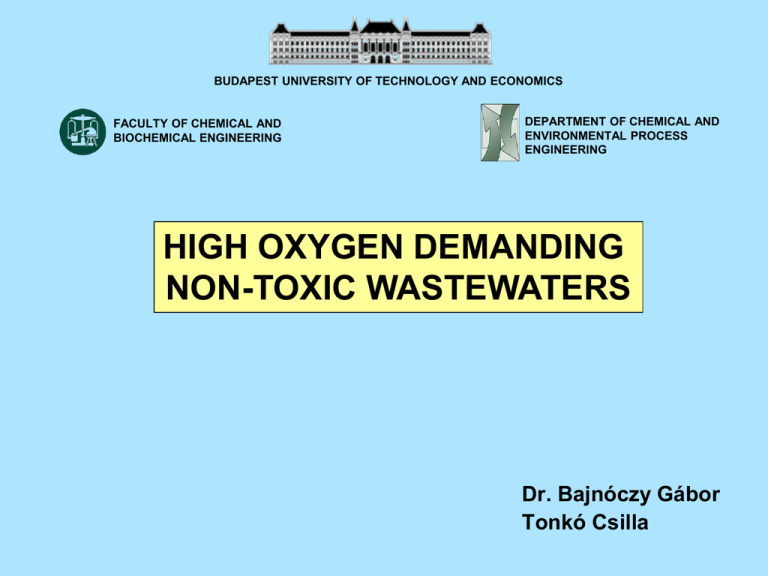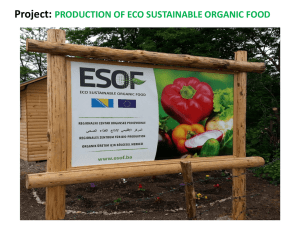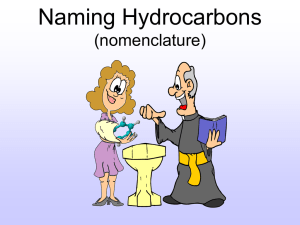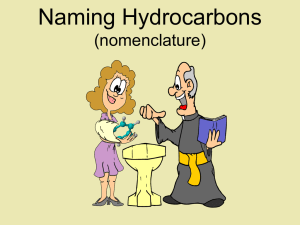Document
advertisement

BUDAPEST UNIVERSITY OF TECHNOLOGY AND ECONOMICS FACULTY OF CHEMICAL AND BIOCHEMICAL ENGINEERING DEPARTMENT OF CHEMICAL AND ENVIRONMENTAL PROCESS ENGINEERING HIGH OXYGEN DEMANDING NON-TOXIC WASTEWATERS Dr. Bajnóczy Gábor Tonkó Csilla The pictures and drawings of this presentation can be used only for education ! Any commercial use is prohibited ! HIGH OXYGEN DEMANDING NON-TOXIC WASTEWATERS Contain significant amount of biodegradable organic matter, non-hazardous to aquatic life. Main sources: livestock food industry liquid manure municipal wastewater EFFECT OF HIGH OXYGEN DEMANDING, NON-TOXIC WASTES ON NATURAL WATER Dead organic matter in natural water (leaf, dead corpus, etc.) is decayed by bacteria using dissolved oxygen. The process is named mineralization and the final products carbon dioxide and water. Number of aquatic bacteria is limited by the available organic matter high oxygen demanding wastewater flows Into natural water number of decomposing organisms increases significantly oxygen consumption increases ↓ dissolved oxygen in water decreases Increase of nutrients for the bacteria natural water: aerobic anaerobic The process induced by non toxic organic materials in natural waters PRODUCTS OF BIOLOGICAL DEGRADATION, AEROBIC AND ANAEROBIC CONDITIONS aerobic: oxygen is available ; anaerobic: lack of oxygen; anoxic: oxygen available only in form of eg.: nitrate, sulfate Independently of water condition – aerobic or anaerobic – life is always present, only the living forms and the final product of organic metabolism differ (aerobic or anaerobic bacteria). Aerobic conditions Anaerobic conditions carbon CO2 carbon CH4 nitrogen NH3 HNO3 nitrogen NH3 amines sulfur H2SO4 sulfur H2S phosphorus H3PO4 phosphorus PH3 other phosphorus compounds Flame in marsh. phosphorus hydrogen + air exothermic oxidation The heat evolved ignites the methane BIOLOGICAL DEGRADATION OF ORGANIC COMPOUNDS 1. terminal oxidation of the carbon chain cytochrom-P450 (iron-containing enzyme) + oxygen in molecule R – CH2 – CH2 – CH3 R – CH2 – CH2 – C - OH R – CH2 – CH2 – COOH Simplified mechanism of the terminal oxidation and the formation of carboxyl group at the end of chain 2. step: β – oxidation enzymes playing significant roles in the process: koenzyme – A : CoASH (reactive center: –SH thiol group) hydrogen transfer enzymes: oxidized form reduced form FAD FADH2 NAD+ NADH O R – CH2 – CH2 – C - OH O CoASH R – CH2 – CH2 – C - SCoA - H2O FAD OH O R – CH – CH2 – C - SCoA O H2O water addition (Markovnyikov rule) NAD+ O FADH2 R – CH = CH – C - SCoA NADH O R – C – CH2 – C - SCoA H2O O R – C - OH instable compound in water decays immediately O + CH3 – C - SCoA acetil-koenzyme A carbon chain is built backwards by the program of microorganism using this unit In case of energy demand: citric acid cycle carbon dioxide and water BIOLOGICAL DEGRADATION OF ORGANIC COMPOUNDS 1. Long chain carbon compounds (number of carbon atoms > ≈ 32): poorly decomposable or remains intact. This form is not favored by energetically This form has lower energy ? microorganism doesn’t find the end of chain ? Some bacteria have exocellular chain splitting enzymes. Short-term gains, the chain terminal disappears in ball. plastic degradation is very slow in nature 2. Branched carbon chain compounds: no or slow degradation O R – CH – CH2 – C – OH CH3 CoASH - H2O O R – CH – CH2 – C – SCoA CH3 FAD OH O R – C – CH2 – C – SCoA water addition (Markovnyikov rule) CH3 O O R – C = CH2 – C – SCoA CH3 O R – C – CH2 – C – SCoA CH3 H2O FADH2 Motor oils contain mainly branched hydrocarbons, so the effect on environment is long-term. 3. Aromatic compounds: aromatic ring slowly, but biologically degradable cytochrom OH COOH OH COOH O P-450 O COOH O HO – C – C – CH2 - COOH cytochrom P-450 OH + CH3 – COOH 4. Highly condensed aromatic ring: not degradable Carcinogenic compounds containing highly condensed aromatic rings decay a few hours in atmosphere (sunshine), but toxic effect takes a long time in water and soil. ORGANIC MATTER CONTENT OF WATER, BOD AND COD BOD (Biological Oxygen Demand) The oxygen quantity in a unit of water, necessary for the biological oxidation of organic matter during 5 or 20 days, at 20 °C Unit of BOD5 or BOD20 [mg oxygen/dm3] BOD5 necessary oxygen quantity for the biological oxidation of organic carbon compounds BOD20 necessary oxygen quantity for biological oxidation of organic carbon and nitrogen compounds degradation of nitrogen compounds starts later BOI organic nitrogen-containing compounds day desamination NH3 NH4+ + 1,5 O2 Nitrosomonas NO2- + 0,5 O2 slow In aqueous medium H2O + 2 H+ + NO2- Nitrobacter fast NO3- ORGANIC MATTER DEGRADATION IN NATURAL WATERS approximated by first-order reaction BOD t: residual oxygen demand at the t time, BOD 0: total biological oxygen demand at the beginning t=0 k : air supply constant at a given temperature BOD t = BOD0 *(1 – e -kt) Air supply constant water type Little lakes, dead branches Slow flow Large, slow water flow Large, normal water flow Fast flow k [day-1] 20°C 0,1 – 0,23 0,23 – 0,35 0,35 – 0,46 0,46 – 0,69 0,69 – 1,15 Conversion to other temperature: k(T) = k(20°C)*1,024T-20 COD (Chemical Oxygen Demand) The oxygen quantity in a unit of water, necessary for the chemical oxidation of all dissolved or suspended organic matter by a strong oxidizer (potassium dichromate or potassium permanganate). The final product of the oxidation : CO2 and H2O. Unit of COD [mg oxygen/dm3] Relationship between BOD and COD BOD < COD General relationship, the chemical oxidizer disintegrates all organic compounds, but the microorganisms are choosy. BOD = COD Water sample contains only biologically degradable organic compounds. BOD << COD Water sample may contain toxic compounds or only small amount of biologically degradable organic matter. SIMPLIFIED AEROB BIOLOGICAL WASTEWATER TREATMENT Accelerated biological degradation of organic matters by activated sludge in continuous aerobic fermenting tanks. anoxic basin: a.) pre-degradation of organic matters b.) ammonification (organic nitrogen → ammonia) c.) denitrification of recycled purificated wastewater (nitrate → nitrogen) aerobic basin: a.) air supply b.) oxidation of organic carbon c.) ammonia (formed in anoxic basin) oxidation to nitrate d.) increase of sludge mass AEROB BIOLOGICAL WASTEWATER TREATMENT SIMPLIFIED ANAEROB BIOLOGICAL WASTEWATER TREATMENT Accelerated biological degradation of organic matters by activated sludge in continuous anaerob fermenting tanks. COMPARISON OF WASTEWATER TREATMENT TECHNOLOGIES AEROB ANAEROB carbon content In form of carbon dioxide (~50%) organic matter content of waste water (100%) carbon content of sludge ~50% carbon content of biogas 90-95 % methane : carbon dioxide ~ 50-50 % organic matter content of waste water (100%) carbon content of drain water ~ 1% - well known technology - aeration: energy intensive - sludge disposal problem (heavy metals) - sludge fermentation → biogas - sludge incineration (ash content: < 60%) (organic matter: > 25%) (water content: < 50 %) carbon content of sludge ~1-5% carbon content of drain water ~ 1-5% - lesser-known technology - large body of water –> warming problem - less sludge formation - fuel gas formation - sensitive to toxic matter - COD > 2000 mg/dm3 - higher capacity - 1 kg organic matter ~ 1 m3 biogas











